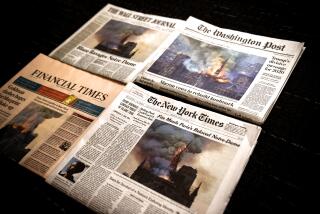PERSPECTIVE ON PUBLISHING : Be Prepared to Be Dazzled : Tina Brown takes over a New Yorker that hasn’t sparkled for decades. She’ll bring it news sense and fine writing.
- Share via
When I started New York magazine in 1968, there were many cries from the defenders of the status quo--how dare I move into the presumably sacred ground of the New Yorker. But I knew something they didn’t know--that the New Yorker had left a hole right at the heart of New York readers.
It had only about 20% of its circulation in all of New York state and far less in the metropolitan area of New York City. In other words, the New Yorker was misnamed; it had turned into essentially a suburban magazine. It literally had become the magazine for the old lady from Dubuque, the opposite of what its founders intended. The question becomes: Why publish weekly if you don’t deal with the urgent concerns of the moment in an intelligent way?
Previously I had realized that the writing in the New Yorker too often slid into dull academese. This thought was crystallized in Tom Wolfe’s famous 1965 articles in the New York Herald Tribune analyzing the New Yorker and its endless subordinate clauses that made the writing so dull, so often, that readers were lost in the “Whichy Thicket.”
New York magazine moved into much of the area that the New Yorker had vacated. We did very well, capturing the city readers and much else, as did a number of other magazines, all taking chunks of the audience.
But the New Yorker’s great prestige, and its occasionally vital articles, kept it from changing to keep up with the times. In fact, in many ways it retrogressed from the lively, feisty, early years under its founder, Harold Ross. As the years went on, many of its better writers moved on, and the deadwood left behind began to pile up. Tom Wolfe referred to them as the “Tiny Mummies of West 43rd Street.” Holding fast to the status quo, they began to steadily lose advertising, until the founders prudently sold it to Si Newhouse of Conde Nast, who, with firm purpose, fired the old editor and put into his place one of the most prestigious editors in the country.
But the new chief, Robert Gottlieb, was a book editor, not a magazine editor, and he held in contempt journalism and journalists. Perhaps the most famous New Yorker article of his tenure essentially argued that all journalists were con artists, in the business of betraying their subjects. This was one of the rare instances when everyone actually read and talked about a New Yorker article.
There were the usual occasional flashes of editorial strength amid the pages of a magazine that made only pro forma nods to the onrushing contemporary world. But in too many ways the magazine continued in its traditional, even fusty habits.
Si Newhouse, who had invested in the neighborhood of $100 million in the New Yorker, began looking for more payoff after five years of continued adherence to tradition. The recession also concentrated his mind powerfully.
Last week, Newhouse installed the hottest editor of the ‘80s, Tina Brown, who rescued Vanity Fair and made it the most successful and talked-about magazine of its period. Brown is an Oxford-educated journalist with news-oriented instincts and drive. She was regularly breaking and making news with a monthly magazine--beating daily newspapers and weekly newsmagazines. But she lost too many stories because of her long lead time, which frustrated her news-driven personality. Unlike too many newsies, however, she puts equal value on fine writing.
At this point I must declare my own interest. My wife, Gail Sheehy, wrote a number of news-breaking political stories for Vanity Fair and received strong support from Tina Brown. Her current best-seller, on the distinctly non-glitzy topic of menopause, grew out of a Vanity Fair article. So did William Styron’s brilliant account of his battle with depression, “Darkness Visible.”
Tina Brown recruited many of the brightest new talents of today, making Vanity Fair a showcase for contemporary writers. What she will do with the New Yorker won’t be Vanity Fair. What it will be is a vibrant new New Yorker.
With Vanity Fair she was the editor of the ‘80s. With the New Yorker she will be the editor of the ‘90s.
More to Read
Sign up for our Book Club newsletter
Get the latest news, events and more from the Los Angeles Times Book Club, and help us get L.A. reading and talking.
You may occasionally receive promotional content from the Los Angeles Times.










